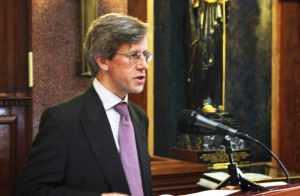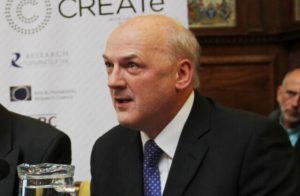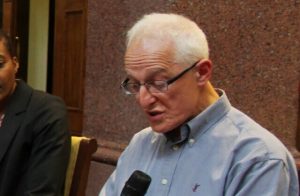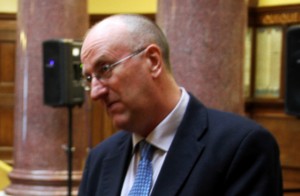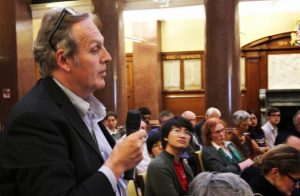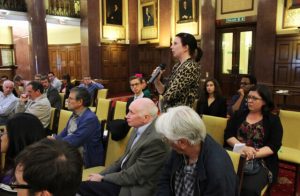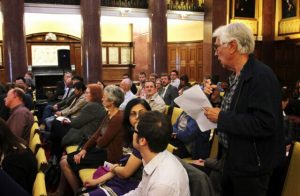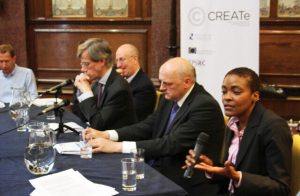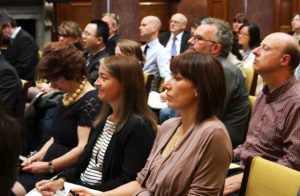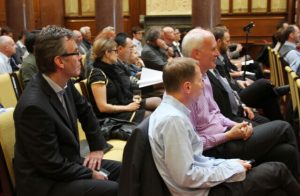Orphans and Images Transcript
Speakers
Hon. Mr Justice Arnold, Judge in charge of the Patents Court, UK High Court Chancery Division
Richard Boulderstone, Director, e-Strategy and Information Systems, British Library
Matthew Cope, Head of Digital Technology Team, UK Intellectual Property Office
David Hoffman, Lead Moderator, Editorial Photographers UK
Derek McAuley, Chief Innovation Officer (In Residence), TSB Connected Digital Economy Catapult
Ros Lynch, Head of Copyright Licensing Co-ordination Office, Copyright Hub UK
Jeremy Silver, Non Executive Director, Bridgeman Art Library
Hon. Mr Justice Arnold (HMJA):
So given the time is moving on we will dive straight in and we’ve got six panellists to talk to you this evening. They’ve each been given the grand time of four minutes, which hopefully will keep things snappy. They’re going to be addressing you in alphabetical order, which means that Richard Boulderstone from the British Library is first.
Richard Boulderstone (RB):
Hello, I’m Richard Boulderstone from the British Library.
I did have an opportunity to look at the report today; I downloaded it, read the executive summary. I think it’s really helpful in terms of pointing out the incredible complexity there is around the world in dealing with this problem. And I can speak from a book perspective because we, the library, have digitised quite a few books. Although we have digitised several hundred thousand books, we have 15 million in our collections and for most people in the UK those books might as well not exist. Because in order to gain access you have to come to Euston Road, you have to get a reader’s card, you have to sit in the reading room, you have to order them up from our basements and you have to wait there until you get them.
I think in the digital age it’s amazing that – while we have the technology to provide access to all that material online – there are massive barriers to providing it, not least of which of course is the law. The cost just to digitise these materials when we do get that opportunity is pretty high anyway; it costs us about £200 to £300 per book to digitise it. We ourselves have not funded a digitisation project of books because we simply can’t afford it. The people we work with to digitise books are Google, Microsoft and a few others who have funded digitisation projects, but only sadly books of the 19th century. The notion of trying to clear rights particularly at any of these prices is just completely beyond our doing, it just takes too much time. And so I would urge us if we can come up with a mechanism to clear rights to make it as automatic, as fast and efficient as absolutely possible, because only when we get the cost of doing that down to a few pence per book are we going to get anywhere near a system that we can effectively use as a public sector organisation, and frankly a holder of the nation’s intellectual memory.
HMJA:
Thank you, Richard, that was very short and sweet. Our next speaker is Matthew Cope from the IPO.
Matthew Cope (MC):
Thanks. So there are quite a few familiar faces here today, but for anybody who doesn’t know me I’ve been involved with copyright policy for the IPO for a number of years now, which means I’ve had an awful lot of conversations about orphan works. Martin [Kretschmer] summarised earlier the Gowers Review recommendations of 2006 and the Digital Britain Report 2009 also suggested we should do something to address this. Ian Hargreaves’ recent review of IP and Growth recommended that provisions for dealing with the orphan work problem be brought into UK law.
The first half of the study summarised earlier shows we’re not alone in having this focus, an increasing number of jurisdictions across Europe and further afield either had lawful work schemes for some time or are introducing them. And of course we have the European Directive on the same subject. Now, I know this is a topic which people feel strongly about, we’ve had a lot of lively debates outside of Parliament and within Parliament quite recently about whether or not we should have a solution at all. We are now looking at how we can use technology to make sure that we reduce the number of orphaned images in the future, and make sure that as many works as possible retain their attribution and their ownership information throughout their term of protection.
The report published today mentioned that there doesn’t seem to be a great use of orphan licensing schemes for contemporary photography, there might be a number of reasons why that is. With the number of images being created increasing more than ever before anything we can do to help preserve ownership information and keep the attribution following images around has to be of great benefit to everybody in years to come. When you talk to people involved in copyright policy about this kind of problem, sooner or later talk turns to registration and the benefits that mandatory registration gives you in terms of tracking ownership, making licensing more simple and making enforcement disputes simpler to resolve. Now, obviously in the UK we can’t introduce mandatory licensing even if we wanted to. It’s not necessarily a good fit for something where we all create copyright works every day often without intending to. It seems to me though that technology might provide us with a different means of cracking the same nut. We have image recognition to a point that free services are available that would search the entire breadth of the web, we have technology which can recognise images that have been cropped, coloured, mutated, stretched, generally messed about with. We also quite commonly have cloud computing that is reducing the cost of processor intensive activities, bandwidth intensive activities, like image recognition, making it more affordable, making batch processing easier.
In the news we have an increasing awareness of the importance of metadata and the problems posed by metadata stripping, Ros [Lynch] might say a few words about that, and the work that the copyright licensing steering group are doing to find a voluntary solution to some of those problems. But my question I think to everybody here is: when we appear to have all the technology required for images to either maintain information as they travel around, or to be easily identified at a later date in the process, what is missing? What are the either technological barriers or the market failures which are preventing us from having a situation where ownership information is contributed to the images and we don’t have new orphans being created of images. This is not just idle curiosity either, we actually have been looking at this seriously. The Secretary of State for Business is keen to be working with the TSB [Technology Strategy Board] to look if there was something we could do in this area to make it easier for photographers to track down images that have been used. Obviously image recognition technology is very mature, it’s not something where there’s much low hanging fruit we can step in and help with. But if there are barriers, if there are failings there, we’d be interested to discuss those.
HMJA:
Thank you, Matthew. And our next speaker is David Hoffman from Editorial Photographers UK.
David Hoffman (DH):
Good evening. Martin [Kretschmer]’s conclusion in his report firstly caught my eye really. I’ll just read you a couple of lines from that. “None of the examined orphaned work schemes appears to be working well. In none of the examined jurisdictions did we notice a great demand for licences for contemporary photographs or images. In short, under-use rather than over-use of orphan works seems to be the issue.” And perhaps to conclude that orphan works schemes cannot work well. While there has been no shortage of efforts to come up with an effective scheme, it’s clear that all the existing solutions are cumbersome, unfair and inadequate. This is hardly surprising, the orphaning of photographs whether by incompetence or design does real damage to those works and that damage has a cost. It’s a cost that we’re paying now in the loss of availability and the additional workload required when we need to use those damaged – I’d rather say vandalised – works. Photographers want to make their work available, that’s mostly why they create it. But if they’re to continue to create they need to also derive a fair income from their exploitation and to be able to prevent unacceptable use. Orphaning works not only deprives the photographer of these rights but as we see from this report it makes using the work in ways that benefit us all far more difficult and complex. Clearly there can be no perfect solution to our inherited orphaned work problem, but there are fairly simple things we can do to avoid continuing to create even bigger problems for the future. In the last couple of years as many new photographs have been created as have previously existed. As fast as they’re made, Google, the BBC, social media and many others make orphans of them, deleting valuing attribution and descriptive data, even as they stuff their servers with the work of others. It’s madness for us to concentrate on devising ways to clear up the historic mess of orphan works that we are faced with while we do nothing to stop this accelerating process.
During the digital economy bill debates Lord Richmond said “it’s a logical legal absurdity to talk of licensing works whose authors cannot be identified”. Well, there are still significant groups of authors who do not have the right to be identified. It’s not rocket science. I’m amazed that despite the proposals we see, the legislation, the endless rounds of discussion and meetings and reports we’re still no closer to establishing a right for a creator to be credited or for a duty of care towards photographic metadata. That has to be central to any solution of any regulated system. We’re here to look for solutions. These two simple provisions would effectively stem the creation of orphan works. We’ve argued for a right to credit in the 1988 [Copyright, Designs and Patents] Act when it was drafted, we’ve argued for enforceable moral rights; we didn’t get either. We’ve argued for it at every opportunity ever since; they weren’t in the Digital Economy Act, they weren’t in the Enterprise and Regulatory Reform Act. There’s no provision for them in the IP bill. The blame for this can only be laid at the door of the IPO who have consistently turned a deaf ear to the repeated arguments from just about every concerned organisation in the sector.
We look at what existing orphan works seem to teach us. Many of us have put in a great deal of effort into constructing new registry regimes. These will be an important part of any future solution. This is necessary and helpful, but you can’t bail out the boat while you have a massive hole below the water line. If there is to be one single thing that cries out for immediate action it’s a robust and enforceable mechanism to tie our ownership to our work. The rest will follow. Thank you.
[Applause]
HMJA:
Thank you to David Hoffman. And our next speaker is Derek McAuley from the University of Nottingham.
Derek McAuley (DM):
So I think I’m the non-copyright expert expert here, I’m a technologist. We’ve heard the comments made. I can’t think of any technological reason why we’re not propagating metadata and I will not even try and make an excuse for the industry in this case. The technology industry is full of folks who are keen to get a product to market as fast as they can and have very little training in many aspects of life, privacy is the one that I’ve spent a lot of my time being concerned about and the activities of social networks and others online. The copyright aspects I’ve come to appreciate through activities within CREATe and also before that talking with BFI [British Film Institute] a number of years ago, and more recently with Tate trying to look at these cultural archives.
And I do think that we need to step up the game here and I want us just to take what happened around Instagram as an example. I do worry that in our discussions around copyright we focus, and I’ll say it, and please excuse me for a minute, we focus unduly on the professional in the internet era, when in fact the voice of the masses can have a much larger impact. So Instagram and its rather annoying (and what should have been illegal) change of terms and condition, while professional photographers were appalled, and they probably weren’t using Instagram anyway, it was the mass audience that got Facebook to change their attitudes. I do wonder if we can look at digital copyright exchanges of the future and our rights management and understand that copyright, especially images is one of the few intellectual property rights that the average citizen actually generates on a day-to-day basis. They take pictures, they upload them, they don’t write songs, they don’t make videos, they don’t make TV, they don’t write books. Imagery is unique in that it’s a creative act that many of us engage in every day. And actually using what the internet is about and being a democratisation of content and things, actually using that as a force, we’ve seen the big backlash. A lot of the rhetoric out there has been about they’re going to steal all our social network images. Let’s try and use that imagery to push towards some of the requirements that are being asked for here in terms of mandatory registration. Technically I should be able to put a default licence and an identifier in there that identifies my image in my iPhone, in my camera, and every time I take a picture metadata is captured, all tools in the chain maintain the metadata, and I really don’t understand the technological issue. But what we need is the motivation behind it, and I would appeal that in looking at our solutions for digital copyright registration that we actually do think about motivating the mass of the population behind this activity to also then have the benefits for the professional photographers.
HMJA:
Thank you, Derek. And our last panellist is Jeremy Silver who this is evening is wearing his… Sorry, I’ve missed Ros [Lynch], the most important person, apologies to Ros, who of course is from the Copyright Hub itself.
Ros Lynch (LS):
Thank you. For those that don’t know, Richard Hooper was commissioned by the Government to carry out a feasibility study into the creation of a digital copyright exchange which was one of the recommendations from the Hargreaves Review. And Richard published his report almost exactly a year ago and there were probably two recommendations in that report that were relevant to the discussions this afternoon. One is the big idea: the creation of a Copyright Hub, and the aim of the hub is to make it easier to license, make the process of licensing easier so that we could remove some of the excuses that people use in terms of not knowing where to go and who to ask for permission, et cetera, and also to help people to understand who owns the right to what. He also saw the hub as a place where creators and photographers, whoever, can come in and through one mechanism register their copyright work, register who they’ve given permission to. He recognised that registration is not mandatory but he does see this as a way of helping the creative industry to retain their rights and to reduce the level of infringement.
The other recommendation which is relevant (and which we’ve spent quite a bit of time working on this year) is to actually try to prevent future orphans. So we’ve had a group working on creating a code of practice, on creating and maintaining metadata. The code is aimed at helping photographers to see the benefits and the importance of putting useful metadata in the images, and for those that use images and professionals, it’s about helping them to understand why it’s important not to strip that metadata out, or if they have to remove the metadata for part of the workflow process, of keeping that metadata somewhere so that they can always get back to the original creator and show that that creator is paid for, or if they don’t want payment they’re acknowledged as being the original creator of the work. We’ve currently got a document out to consultation, it was launched on the 27th June on a voluntary code of practice and I do urge you to go and have a look at the code and give your views. You can find it at www.clg.info/codeofpractice. So it closes on the 28th August, and the intention is if it is felt by the industry, that is the creators, the photographers and the users of images, that the code of practice was useful then it’s about finalising what should be in that code of practice. Thank you.
HMJA:
Thanks to Ros, apologies again for missing you. And then finally to Jeremy Silver.
Jeremy Silver (JS):
Thanks. This is such a vast and complicated problem; inevitably everybody who talks about it always seems to come from some particular angle or perspective. I’m speaking this evening with my Bridgeman Art Library hat on; the Bridgeman Art Library is a picture library that licenses cultural and historical art images primarily for use in publishing and being in the press and adverts and so on. And I advise them on a non-executive basis and I also have been involved in various other areas of copyright policy, formation and discussion and practical projects as well on the music side of the fence.
With Bridgeman recently I was quite involved in a project with the BBC which was called Your Paintings, which some of you may be aware, it is a website which was aimed at hosting the nation’s oil paintings collection, which were progressively photographed and digitised and then put up on the site. And Bridgeman and the BBC tried to collaborate to clear a series of rich media clips that could illustrate and flesh out and add to the stories of the paintings themselves, and this involved trying to clear the rights in various clips from programmes of old series, like some of you may remember Kenneth Clark’s Civilisation series for example, trying to just clear relatively short clips from an old TV show like that. And it was incredibly difficult to do, it was incredibly time consuming. The amount of money that Bridgeman lost in the process of doing that because of the amount of hours it all took to try to…not even beginning to contact rights holders, but simply to try and identify who all the rights holders might actually be, the endless discussions about what degree a part of a picture in the back of a frame of a particular shot should or shouldn’t also be cleared. These end up being the practical considerations that people embark upon before they even find out whether what they’re dealing with is orphaned work or not.
And I mention that partly because it’s a practical example of something that I’ve been involved with but also it give you a sense of the complexity, which I’m sure you’re all aware of, but I think it’s worth pointing out. It seems to me that there are two very, very different problems as well here.
One is the problem of history and the other is the problem of going forward in the future. And it seems to me that it would be absolutely madness, and unfortunately our debates are often clouded by a degree of madness which compounds trying to solve the problems of the past and also trying to prevent problems with the future. These seems to me to be ones that require separation, and at the moment one starts to do that at least there’s some degree of clarity might come about. So lots of people have talked about rights registries, even our most activist friends in Stop 43 I believe are quite interested in the concept of some sort of rights registry which will allow an image when it’s produced to be lodged somewhere, to have its metadata associated with it and therefore to be traceable, trackable and so on. We talked about technological solutions, to do exactly that work of tracing images that have been abused across the internet.
They use it fairly rigorously, it works in some cases and not in others, but it’s as good as it could be at the moment and from a commercial point of view it seems to me there is a solution there that people should be able to use. So I think what we have to ask ourselves when we think about policy, given that degree of complexity, given the fact that we have a future looking problem as well as a past problem, is what are we actually trying to achieve? Whose interests are we trying to serve here and what’s the point of the policy that we’re trying to put in place? And clearly what we’re trying to do is balance both our public interest and public right to access material as well as a commercial interest which is designed to try and actually aid growth and help the economy by being able to take these sorts of images, develop them and provide some sort of commercial avenue, as well as in the end to provide some protection and obviously moral backbone for the artists and the creators themselves. And we’ve talked a lot about images, and as we know, one of the complexities of all of this is the fact that the situation with images is different from music, is different from all the other areas, and each of these has its own issues.
So it seems to me that we need to make some very clear separations. But the biggest problem that I’ve encountered in every single piece of policymaking conversation around this, and some of the other areas of copyright policy formation in the last few years has been the endless clouding of the debate, the confusion, the lack of agreement on what meanings of words are, the idea that we couldn’t even agree on what the definition of orphan was because some people thought that orphan meant the capability of being orphaned in the future, the potential that the work might become orphaned, as opposed to whether or not it was orphaned, i.e. people couldn’t identify whether or not they had the rights or not.
Those sorts of confusions clouded the policy debate, I think we have to clear and clarify, we have to separate these issues out. There is little prospect of our getting there to be honest. Having gone around and around all this I feel despair at the concept that 20 per cent of the nation’s cultural riches will sit locked up in its archives, in the BBC, in the British Library, in our museums, in our archives and in endless different projects because of the obdurateness and the legal incapacity of any of the agencies who could do something about it to do something, even if they could afford to. Even regardless of the rights, the amount of time, the amount of effort and cost it would take to digitalise regional film archives for example is way beyond what the BFI could achieve even though they’ve tried seriously to do it.
So I think we have to clarify, we have to separate out, we have to agree on terms and we have to separate out trying to find solutions for the future from solutions to do with the past. Thanks.
HMJA:
Thank you, Jeremy. Before I invite some questions from the floor can we start off with two of my own? Rather than asking a question of my own I’m going to allow one panellist to respond to another. David Hoffman has argued very strongly that we should have a legal right of attribution for photographers, and he has criticised the IPO for a failure of leadership in not implementing such a right. So I’m going to give Matthew Cope the chance to respond to that.
MC:
I guess the first point I want to make is: there is a right of attribution for photographers, as there is for all creators, the moral rights framework we’ve had in the UK has been largely unchanged for some years now. It does have exceptions for news reporting and I know it’s a concern of many photographers, it’s something that’s been raised many times previously with us. It is something we continue to look at, it is ultimately not up to the IPO to decide which direction the policy goes in, we reply to ministers and they decide on their priorities and what they want us to look at. But it’s something we have heard increasingly and we continue to look at.
HMJA:
Thank you, Matthew. Secondly, I’m going to ask Richard Boulderstone to comment on one of the points that was made by Martin Kretschmer in presenting the conclusions of the CREATe Report that’s been launched this evening. He suggested that one of the conclusions to be drawn was that for the archives and non-profit institutions the more satisfactory way forward was the limited liability model which has been particularly looked at in the USA, rather than upfront rights codes, and I think will ask Richard as a representative of an archive and a public body in this country what his view on that is.
RB:
Overall it sounds good to me, simply. We’ve heard from Jeremy about balance, I think we are trying to ensure that we do the right thing and follow the law as it stands. I think the problem for us with orphan works is just the complexity of figuring out who if anybody owns the rights, and it’s an expensive process. So if you could have a due diligence process and after that have a limited liability it clearly helps us take a larger risk than we otherwise might take. At the moment we simply just don’t get involved in that stuff because it’s just too expensive and it’s too much liability for us.
HMJA:
But the problem which I’ve heard articulated by public sector bodies before with limited liability is that it involves them acting unlawfully and they’re not prepared to do that even if there’s a statutory limit on the damages that can be claimed.
RB:
Well, we’re clearly not keen to act unlawfully. So we would have to do a risk analysis of what happens, although we do some things which you could say are sailing closer to the wind. For example, because we don’t know we do allow our digitisation projects to stray into the 1880s or 1890s and we may well in those circumstances be digitising things which somebody could claim copyrights over. But we are cautious and we think that the risks there are relatively small. So I think it would depend an awful lot on what the limited liability was, how it would apply and how we treat it.
HMJA:
Thank you. Questions. I hope we’ve got a roving mic somewhere; there was one earlier, if someone could grab a microphone. And if people could just say who they are and where they’re from.
Q:
Andrew Wyatt, British Press Photographers Association. More of a statement than a question, I think it was Matthew Cope that asked the question what’s missing. He gave a forceful answer, he was given a second chance and I found his reply less than helpful. It is not the case that we have moral rights over our pictures, it has to be asserted. Moreover it doesn’t apply in the whole field of editorial publication. I have been in a room full of photographers meeting with the IPO, where we asked why can we not have moral rights to our pictures. The answer came back very clearly – because the publishers wouldn’t like it. Now, until such time as the IPO has the political will to press the case for moral rights we will get nowhere. The answer to your question which was what’s missing was the political will and the IPO’s determination to put things right.
[Applause]
HMJA:
Right, does someone actually have a question? Yes, over here.
Q:
Isabelle Doran from BAPLA (British Association of Picture Libraries and Agencies] which is another photographic organisation. The question I have is with regards to embedded works and how do we deal with these, especially when it comes to books?
HMJA:
Anybody want to talk about embedded works? Richard, perhaps?
RB:
It’s very difficult. Clearly having a work with lots of different rights associated with it is much more complex than just having a single work with one set of rights, and I certainly recognise that that happens a lot. So I think that if a rights registry is to be built (which I think should be), it needs to have provisions to deal with those situations as well as it possibly can. I can’t say much more than that really. It’s just another complexity.
HMJA:
Someone else? At the back.
Q:
John Warren, Merton College. I’m just wondering, one of the assumptions underlying much of this discussion this evening seems to be that in applying an orphan works regime, the same rules apply to all kinds of works regardless of whether they’re literary works or artistically created photographic works. But from the discussion it seems to me that different considerations may well apply depending on the nature of the work in question. And so I’m wondering to the rest of the panel generally, to what extent the different regime may be appropriate in relation to photographs as compared to, say, literary works?
HMJA:
I’ll ask Matthew if he’s got a view on that.
MC:
Clearly you’re right, there are different considerations for different types of work, especially when you come to determining price or the way that different works are sold and commercialised varies massively across different industries. As far as possible I think it would be desirable to have that scheme apply to all types of works, because the cultural value and locked up economic value is there in all types of work. So you certainly wouldn’t want to exclude any particular sector in its entirety without very good reason to do that. But that’s not to say there wouldn’t be differences in approach, certainly the nuts and bolts element of licensing, setting prices and so on depend on the type of work involved.
HMJA:
Pursuing that scene can I introduce an aspect to the discussion which seems to have been neglected so far which is the position of performance, because of course performers have their own rights. Moreover, they are one of the few people who currently have the benefit of an orphan of works provision in UK legislation, Section 190 of the 1988 Act, which actually provides that if you can’t identify the owner of the performers’ right you could go to the Copyright Tribunal and get a licence. Very, very little used. One possible research project for CREATe is to find out why not. But I suspect they’ve got enough as it is! But how does the IPO see the position of performance fitting, first of all the current legislation that’s just been put on the statute book with the passage of the Enterprise and Regulatory Reform Act, and secondly going forward?
MC:
A caveat: this is not my area of speciality, one of my colleagues is actually dealing with the development of the secondary legislation following the Enterprise and Regulatory Reform Bill. They would’ve given you a rather fuller list than I have on the hoof just now. As you say, we already have very minor orphan work provision for performers’ rights, to my knowledge it’s never been used, my colleagues in copyright…
HMJA:
It has.
MC:
It has? A small number of cases I imagine. In the context of the sort of orphan works that might be licensed through any future scheme we have, I can certainly envisage those including performers’ rights, where they involve recordings and suchlike, we would want to be able to license those where performers are unidentified and cannot give their permission. So in that sense the performers’ right would be created the same as the core copyright interests.
HMJA:
Someone else? At the back, yes.
Q:
Emily Hudson, St Peter’s College, Oxford. I suppose my comment is directed most to Matthew Cope but possibly others as well. When you were talking about the importance of metadata and not stripping away rights holder information one of the questions that arose in my mind was well, what about the rights holder, the creator who doesn’t really care. So we put a lot of effort into ensuring that metadata is retained and that information is available but ultimately too there seems to be another question which is about the automaticity of copyright protection and whether or not there should be repercussions of people failing to make any attempt to stay connected with their work. So in terms of registries, there might be a register for licences that have been granted or registers for uses for works that have been used, do we need a register just to say I’d like to maintain my copyright and should that have some sort of legal weight at all, bearing in mind Berne and not having formalities as part of your rights of existence, but can that be a development for remedies? So in short, how do we deal with the difference between the rights holder who cares, the creator who cares and those that don’t really mind?
MC:
Well, I think you answered your own question at the end there, Berne is something of a roadblock when it comes to mandatory registration, whether that be registering your economic interest to control your work or the fact that you don’t care if other people use it. There are things like creative commons licences where people can make a claim to the world that they don’t mind their work being reused. They exist within our existing copyright framework, they’re perfectly legal and we support their use by people who want to use them.
I think at the end of the day this has to be voluntary given the international legal obligations we’re under. So things like the Digital Copyright Exchange, the Copyright Hub may have a role there, it’s a large community of people who want to allow their works to be reused under creative commons style licensing terms, then there’s certainly the possibility that the databases or registers could be set up. We would support that on a voluntary basis, but I’m not sure it’s something where legislation would be needed to underpin that.
HMJA:
I did see a hand up?
Q:
Peter Jenner. Following on, I think the idea that you link registration with enhanced remuneration might be a way of getting around… I’m no lawyer but it does seem to me bonkers that we don’t have some real pressure on people to register their works. And I think it’s interesting that Maria Pallante in America is beginning to talk about the effects of term if you don’t register. It is one of the issues that we’re endlessly extending copyrights so it becomes a bigger and bigger nightmare. We should start thinking about – if you want to get paid you better register your stuff. You still have your copyright, you can still sue, but you won’t get nearly as much as if you’ve registered it. And I think in that context too we could perhaps throw a bone to the copyright boys by saying if you register you can have a longer term and equally if you don’t, if it’s not registered there’s a short term. It’s ludicrous that the British Library can’t digitise our books, I think it’s ridiculous that people can’t put out records from artists from the 60s and 70s when the record companies don’t know that they’ve got them, they don’t know who they are, where they are or what they are. And I just think we need to be much bolder, and I hope that CREATe is going to start being a bit bolder.
That was meant to be a question, I seem to have turned it into a rant…
HMJA:
I’m going to turn it into a question, thank you for your contribution. But I will turn it into a question, I will pose it to Ros Lynch and I will pose it in this way. What incentives do you envisage using to ensure that people register with the Copyright Hub?
RL:
I think we can’t use phrases like ensure people register with the Copyright Hub because we’ve said that the Hub would be voluntary. It would be opt in, it would be up to people if they want to do it.
HMJA:
Sure. How do you incentivise them to opt in?
RL:
I think it’s about actually making…if we point out the benefits of doing it and educate people… I think part of the problem is a lot of people don’t understand how important it is to have your metadata…first of all put metadata in, make sure that it stays with the work. The impression we get is that it’s seen very much as a bother rather than something that would be beneficial to use. So it’s about changing people’s perception of it, it’s about changing people’s perception of using things when they don’t actually know who it belongs to and given them options of finding out exactly where to go and who to go to get the licensing that’s necessarily to use that, to use the creation. If we make things easy then people will come to the hub, people will want to hopefully get a licence and do things legally, and therefore we create more of a market for the photographers, other creators.
HMJA:
Well, that’s interesting, but can I ask you then the question that follows on from that, which is suppose you try and encourage the photographers in particular, if we’re supposed to be talking about images, to participate, what do you say to them when people like David Hoffman come to you and say what’s the use of our participating because our metadata is stripped off our images left, right and centre and there’s no legal redress? Because what they’re going to say to you I’d imagine is well, your code of practice is a very nice idea that you’re consulted on, but it’s going to have no teeth and it’s not going to stop people doing it repeatedly as they’re currently doing.
RL:
I think if you’re getting into questions of legal redress it’s a question for Matt [Cope], because the hub will not be able to set any laws. We can only try to, as I said, educate, encourage, use whatever tools we have, I don’t want to disclose them, but we don’t have a legal tool.
DH:
There are ways in which you can incentivise people I think. Firstly most people aren’t represented here, most people just take pictures, and they’re not really that bothered about copyright; they see copyright as being a thing that actually gets in the way of their enjoying work of all sorts. But if you talk to them about privacy, about having a picture they’ve taken perhaps of their kids playing in the hotel pool, used by the hotel to advertise it, or a picture of their neighbours being picked up by a political party to be used, they get very exercised indeed. Now, if you couple that with some of the technological advances that are already in place… Many cameras, professional cameras in particular, are able, allow you to put in your name and to have it embedded in every picture.
Now, supposing when you bought a camera or a phone, an amateur camera or a phone, you’ve got an extended guarantee if you register it with the manufacturer, that’s pretty normal for many products already. So you go online, you plug your camera into the USB cable and you put in your name, your email address. It automatically connects with the registers, gives you a unique identifier, that’s in the camera, your name’s in the camera, the contact details you want to choose to have recorded are in the camera, or maybe they won’t register it, the camera only needs your identifying number. But by registering it online you’ve got an extended guarantee, you may get other benefits, you may get special offers.
That I think will be an enormous step forward. Every picture then generated would have the data in it and everybody would have their own identifying data. It would be a way in which they can protect their privacy, in which we can all protect our copyrights. There’s lots and lots of other ideas like this, they’re all coming along slowly. But we really need a lead from the organisations behind this, from the IPO. Matthew [Cope] was just saying that there are provisions to prevent stripping of metadata and to give attribution. He’s right, there are. But they’re unenforceable, they’re a chocolate teapot. They’re completely hopeless. There’s never been a case as far as I know over the stripping of metadata. The provisions just don’t work. You have to identify a person who’s done it; you have to show their motivation was ill-intended. We have no protection in reality. The use of registering and automatic registration behind this will I think fix the problem.
[Applause]
HMJA:
We’ve got time for maybe one more question.
Q:
Thank you, I’m Gary Hudson, I’m a curator, and I think what we’re talking about tonight are finished artworks in general. I’m interested in what could be called orphaned concepts. I’ve worked with a lot of visual artists and performance artists, they like the ideas which sometimes don’t come to fruition. So how can we protect that idea being taken by a third party? Is that possible?
HMJA:
That’s a very big question indeed. Generally speaking it’s a given of copyright law that you have to have fixation, prior to fixation there’s no protection through the medium of copyright. But of course there are other legal vehicles available like confidential information. But of course that stops as soon as you let the cat out of the bag. But I suspect that’s rather too large a question for our panel tonight. An interesting question to raise but I think it’s a legal question of some difficulty and complexity.
Yes, one last question over here?
Q:
I’m Philippa Warr, I’m a freelance journalist [including for Wired]. I was wondering where the study leaves us, because the findings seem to be that orphan works, the system as it currently stands across the world is a mess and doesn’t really have any standard, it’s all quite arbitrary. Is that helpful in terms of the next steps that you can take or is it more that there’s likely to be pressure from businesses saying well, it’s just not financially viable if we can’t use the imagery for things? What now?
HMJA:
Well, that’s a very good question to end on. So over to Matthew Cope. The IPO has commissioned and published today not one but two reports on orphan works of which we’ve been concentrating on one this evening. And so the question is how is the IPO going to take this work forward?
MC:
Well, as most of you know we have some enabling provisions in the Enterprise and Regulatory Reform Act. The plan is to bring secondary legislation into force in due course to create some orphan works licensing within the UK. We’re also under an obligation to implement the EU directive of on orphan works. And I think your point about fragmentation points into that, orphan works systems have grown up in various legislations over the years in a slightly adhoc fashion. The EU directive is the first vehicle which is going to start regularising some of that activity, in many cases it will be countries that don’t currently have orphan works licensing and they’ll start doing it in a similar way to others. Others will maybe change their domestic provisions to bring it in line with the way the European system works. We’re also going to have our domestic legislation sit separately to the EU provisions because we believe that there’s value in going slightly further than that which is required by the directive.
In terms of the reports today they both add evidence to the material we have to work with, the process of legislation is a long one, involves lots of impact assessments, economic studies, gathering of evidence, this is all part of that process.
HMJA:
We have reached our finished scheduled time, so I’m going to call a close to the formal part of the proceedings. As you can see there remain drinks to follow, and until then could I ask you to thank all of our speakers this evening.
[Applause]
